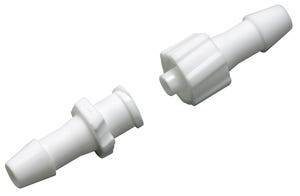International standard preventing medical device misconnections is—finally—on the horizon
It has been a long time coming—more than 10 years, in fact—but it seems that an international standard that defines the design of medical tubing connectors for specific devices may see the light of day within the next 12 to 14 months. Currently, many small-bore connectors used in medical applications have a universal tapered luer design, creating opportunities for misconnections that could be life threatening. For example, there have been cases where feeding formulas and medication intended for enteral administration (i.e.
February 18, 2015
It has been a long time coming—more than 10 years, in fact—but it seems that an international standard that defines the design of medical tubing connectors for specific devices may see the light of day within the next 12 to 14 months. Currently, many small-bore connectors used in medical applications have a universal tapered luer design, creating opportunities for misconnections that could be life threatening. For example, there have been cases where feeding formulas and medication intended for enteral administration (i.e. through the gastrointestinal tract) were provided intravenously to the patient because the connector was hooked up to the wrong device. The ISO 80369 standard would prevent this by standardizing connectors for specific devices. Jim Brown, Medical Business Unit Manager at CPC (St. Paul, MN) and a U.S. expert to the ISO technical committee that has been developing this standard, shared some insights with me at the recent MD&M West trade show and conference in Anaheim, CA.
 "There is no global database keeping track of incidents related to medical-related fluid-handling misconnections," says Brown, "but reported cases number in the hundreds, some even estimate thousands. And many people think the incidents are, in fact, underreported."
"There is no global database keeping track of incidents related to medical-related fluid-handling misconnections," says Brown, "but reported cases number in the hundreds, some even estimate thousands. And many people think the incidents are, in fact, underreported."
When you consider that hospital personnel often work long hours in a stressful environment, it's easy to understand why misconnections might occur. Preventing this from happening is, in some respects, easy—simply adapt connector designs to fit specific applications—but since a plethora of manufacturers are involved who make the various medical components, standardization is easier said than done.
Although it has been more than a decade since the ISO initiative began, progress began to accelerate when the Association for the Advancement of Medical Instrumentation put its weight behind the proposal in 2006. California has also been a factor, notes Brown, with the passage of AB 1867 in 2012. That bill prohibits the use of an epidural, intravenous or enteral feeding connector that fits into a connection port other than the type for which it was intended starting on Jan. 1, 2016.
"California is the only place in the world I know of that has legislated on this," says Brown, who credits the state with ramping up awareness of the issue and stepping in to do something about it.
Currently, the small-bore master standard ISO 80369-1 has been published. Part 1 lays out the general requirements for small bore connectors used in medical establishments to administer liquids and gases and establishes a framework to ensure that connectors for a specific medical application cannot be connected to the wrong device. ISO 80369-3 defining the new enteral connector has been published provisionally. Ultimately, the ISO document's various parts will set requirements for respiratory gas, enteral, urethra and urinary, blood pressure, neuraxial, and intravascular or hypodermic applications. Stayconnected.org has a number of resources on the standard, including a handy timeline of expected transition and implementation dates.
ISO 80369 also weighs in on materials used in disposable connectors. "We are defining rigidity and eliminating elastomeric connectors," says Brown. "We don't want soft, pliable connectors that can stretch and adapt to any other connector. Polycarbonate and most polypropylenes meet the rigidity requirements, but the standard is agnostic when it comes to specific materials, as long as they meet rigidity standards," adds Brown.
Norbert Sparrow is Senior Editor at PlasticsToday. Follow him on twitter @norbertcsparrow and Google+.
About the Author(s)
You May Also Like




